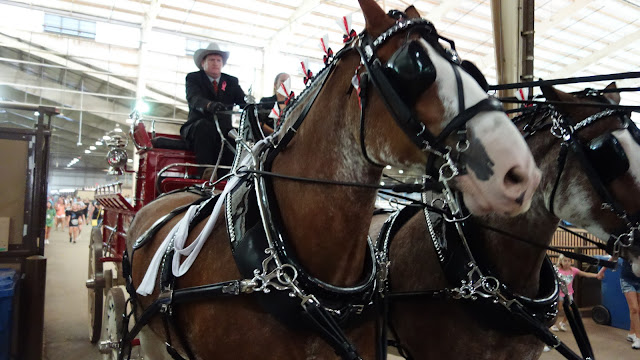 |
A tractor was barreling down Bridge Street toward the Neosho River Bridge. The driver was standing rather than sitting on the seat, with head held high and shoulders thrown back and legs spread wide. It took me a moment to realize it was a woman. She wore a sleeveless shirt and had muscular upper arms; she wore her hair short. She powered past me me on the way to who knows what. She was in command, and she was flying.
 |
| The Neosho River Bridge, built in 1932. |
Yesterday, when my siblings and I were in Humboldt to bury our father, I saw that cousin sitting on the front porch of a farmhouse alongside the road with a large black dog resting beside her. We waved to her and she waved to us. She's in her 90s now. She doesn't farm any more. Another cousin told me she's now a tiny person.
But she still looms large in my memory and makes me think of the type of people who farm in southeast Kansas and a lot of other places in our country. I have tremendous respect for them--for how hard they work, the financial risks they face, their self reliance, and their persistence.
My father, Bob Hamm, was one of them even though, for the last many years of his life, he was no longer a farmer. He was shaped by his farm upbringing. He lived the life of the responsible citizen committed to serving society.
 Dad left Kansas in 1960, but on Friday we buried his ashes in a grave next to our mother in Humboldt's Mt. Hope Cemetery. The cemetery lies just east of the land he farmed when my elder brother and I were children, and just to the north of the spot where a brick factory owned by our ancestors had once stood. He had been born in another farmhouse about a mile from where we stood.
Dad left Kansas in 1960, but on Friday we buried his ashes in a grave next to our mother in Humboldt's Mt. Hope Cemetery. The cemetery lies just east of the land he farmed when my elder brother and I were children, and just to the north of the spot where a brick factory owned by our ancestors had once stood. He had been born in another farmhouse about a mile from where we stood. When I looked at the small hole that had been dug in the earth of the cemetery (by the nephew of one of his childhood friends) and at the rich, almost-black dirt that had been piled next to the hole, I felt that this was the perfect place for him to end up.
We don't get back to Kansas often. A couple of years ago my siblings and I took our father back to his hometown for what we all knew would be his last visit. It was a totally satisfying time--of fond memories of people who have passed away and places that have been transformed. This time our visit was full of love for each other and for our cousins, who kept us company at the grave and around town.
On our visits, we follow a beaten path--stopping at the house where our father was born, the home of our great-grandparents, our cousin's trailer hitch factory, the land our great-great-grandfather farmed on the banks of the Neosho after he served the Union Army in the Civil War, and the downtown square, where our great-grandfather, James Willis Hamm, played the cornet in a small community band that performed in a gazebo on the town square.
 |
| James Willis Hamm, 1865-1947. |
I have done very little actual farming in my life, but I have a romantic attachment to it. On this trip, I asked a cousin if he would mind taking me out in the combine to harvest corn. He readily agreed. I was thrilled.
A combine is like a mobile corn processing factory. The tines on the front strip ears off the stalks as the 25-foot-tall machine moves relentlessly forward, gobbling up six rows at at a time. The machine chops up the stalks, shucks ears and shears the corn from the cob. The corn kernels get blown up a pipe to a hopper sitting on top of the combine and the rest gets blown out the back onto the field.
When my cousin's father and my father were were teenagers, they plowed the fields using mules or horses and harvested corn by hand. Today's automated and air conditioned harvest factories are wonders. But my cousin tells me that some farmers now use driverless combines. Trucks pull up alongside the machines when the hoppers are full and offload the corn without the combine having to stop for a minute.
 |
| Dick Works and a couple of his cousins. |
When we were in the cemetery, before my father's burial, we stood at a nearby grave site while yet another cousin buried the ashes of her grandmother, my father's aunt. My cousin spoke lovingly and movingly of her grandmother.
It reminded me of a truth that I have contemplated repeatedly over these past few years, as I attend more funerals than weddings: History books tell the stories of the march of human progress through the tales of kings and queens, generals, and captains of industry The stories of the millions of regular people are ignored, and, typically, when their children and grandchildren die, they are forgotten. But, in my view, it is these people--people like my father and his aunt and the cousin who drove the tractor down Bridge Street--that really move our civilization forward. I tip my hat with respect to them.
-----
It turns out there's a lot to see and do in the heartland in September. Here are some shots from the Great Oklahoma State Fair, in Oklahoma City. I sampled my first corn dog, and it was delicious.




